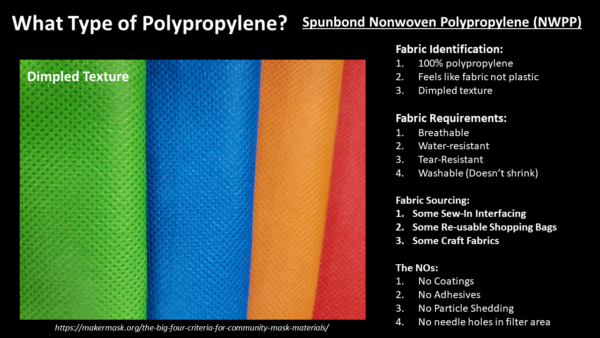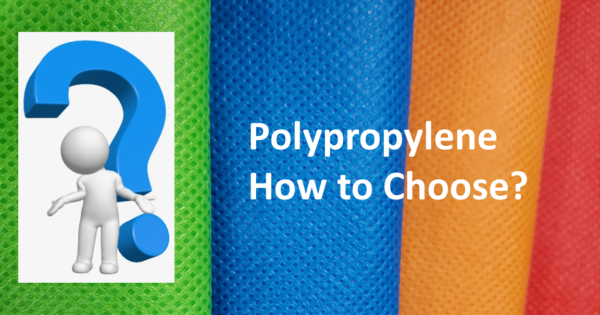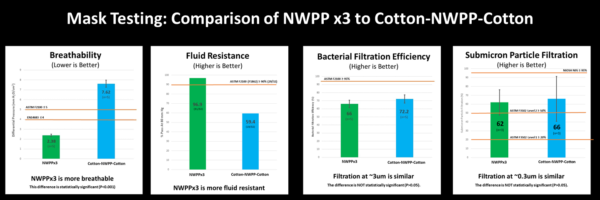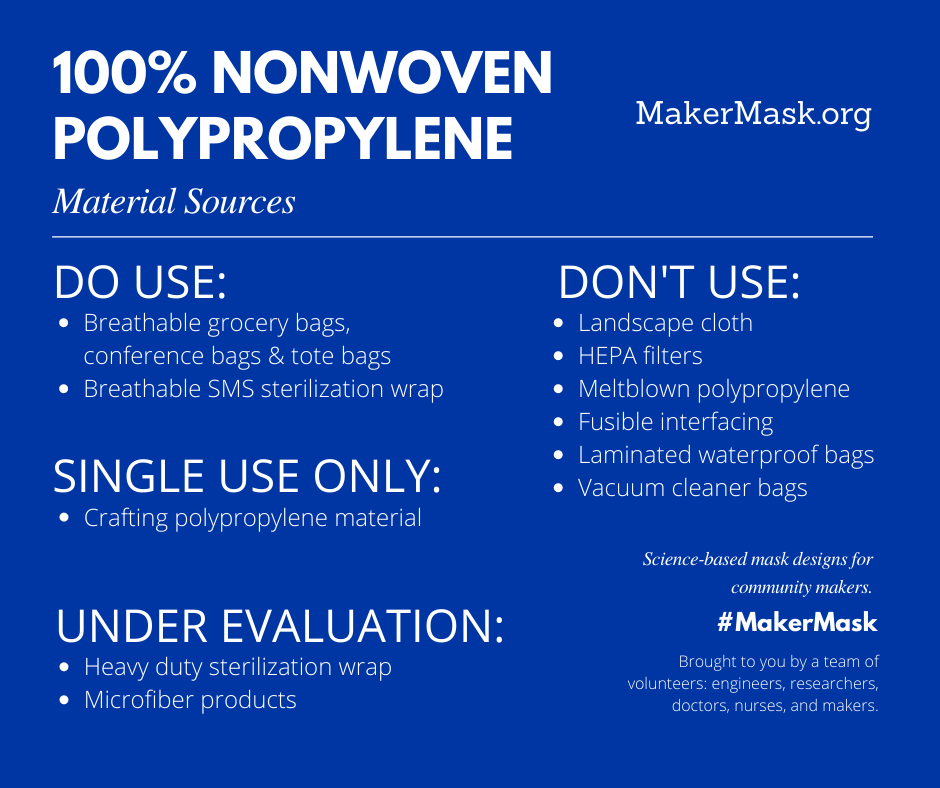This deep dive post looks into the “Big Four” criteria evaluated in preliminary assessments of fabric mask materials: 1) material characteristics, 2) breathability, 3) water-resistance, and 4) disinfection options. More specifically, we focus on spunbond nonwoven polypropylene (NWPP), which is commonly used in commercial face masks. Here we take a more in-depth look at the 4 preliminary criteria considered when evaluating potential sources of spunbond NWPP.
1. Mask Material Characteristics & Sourcing
MakerMask designs use community-sourced 100% spunbond nonwoven polypropylene. Although ideal medical grade NWPP is not currently available for community use, spunbond NWPP is available at different weights and grades for other household and/or commercial purposes, such as reusable grocery bags, some craft fabrics (e.g., Smart-Fab and Oly-Fun), and some sew-in interfacing.
Although medical grade NWPP (20 – 25 gsm) is used in commercial masks and respirators, for ethical reasons these materials are currently reserved for manufacturers that best meet medical, legal, and regulatory standards. Given that these medical grade NWPP materials are not widely available to the public at this time, the preferred sources of spunbond NWPP for use in community masks has been bolsas reusables de compras. (~70 – 100 gsm). However, NWPP from reusable grocery bags is not readily available to sewists and mask makers by the yard. As a result, spunbond NWPP that is more commonly available by the yard (i.e., that used in clothing, textiles, crafting, and upholstery applications) is being investigated for suitability for use in masks. Recent testing results of the breathability, filtration, and fluid resistance of spunbond NWPP used in some craft applications (i.e., SmartFab Backgrounds, ~65 – 70 gsm) suggests it may be a good choice for use in community masks.
- Click here for more information about finding and selecting polypropylene for use reusable masks
- Click here for more information on mask testing results (consistent with ASTM F3502 & ASTM F2100) for spunbond NWPP craft fabrics

Mask Material Identification: Spunbond NWPP
Some sources of spunbond NWPP (e.g., bags constructed from 100% Spunbond NWPP) may be identified by either a tag indicating “100% Polypropylene,” or the indicador de reciclaje “#5 PP”. In addition to material composition, it is important to identify the spunbond nonwoven structure of the material. This can be accomplished by looking for the characteristic diamond-shaped dimpled pattern.
TOP CHOICES: Reusable Grocery Bags (typically 70 – 100 gsm)
Spunbond bolsas PPNT de comprar comida are designed to be in contact with food and have a greater consistency in material properties, manufacturing, and safety than materials used for things like craft projects and landscaping. Since they are designed to carry food, they have minimal particle shedding, and are designed to withstand washing and/or disinfection. Spunbond NWPP materials provide a balance of water-resistance, mechanical filtration, and breathability. Although NWPP bags are thicker than many materials, they work well as mask layers (especially outer layers).
- NOTA: Do not use bags that are finished with a laminated waterproof coating or bonded to insulation as these may compromise breathability.
- NOTA: Spunbond NWPP Conference Bags (typically 60 – 90 gsm) may also be considered: The material weight of conference/promotional bags is more variable than that of reusable grocery bags, and often includes lighter weight and/or softer materials.
TOP CHOICES: SmartFab Backgrounds (typically 65 – 70 gsm)
Smartfab Backgrounds (aka doubleweight) is 65 to 70 gsm crafting material constructed from 100% NWPP. Recent laboratory testing of multi-layer Smart-Fab samples and mask prototypes suggest that it may be a good choice for use in community masks based on its performance relative the ASTM F3502 barrier face covering standards.
CUIDADO:
Safety and usability of NWPP from alternatively sourced materials cannot be assumed. Special caution is recommended advised when considering meltblown NWPP, fusing interfacing, landscaping materials, surgical barrier materials, and crafting materials.
Materials Selection FAQ
2. Respirabilidad
Breathability is an important factor in face mask design and materials selection. Unfortunately, the materiales que bloquean gotitas y partículas más efectivamente, típicamente tienen respiribilabilidad, ajuste, y usabilidad mal. Preliminary breathability checks for novel masks/materials frequently begin with qualitative functional assessments from developers and users. However, quantitative analysis of breathability, including tests of the pressure drop across the mask and CO2 accumulation, are important for verifying usability. For masks designs that are not focused on creating a tight seal/fit to the face (e.g. pleated masks), both air and CO2 pueden escapar alrededor de la máscara. Para máscaras ‘evaluado para ajuste’ con buen ajuste y requisitos para filtración de partículas submicron, éstas medidas de respirabilidad llegan a ser críticas para el éxito de la máscara.
Fabric Layering Combinations
Investigación sobre el número óptimo de capas de PPNT sigue, sin embargo datos preliminares del laboratorio suggests that three layers of spunbond NWPP provides adequate breathability for diseños de máscaras ajustadas y no ajustadas. Despite qualitative assessment to the contrary, masks with additional layers began to show decays in performance (e.g., increased pressure differential across the mask and suboptimal CO2 accumulation). The ideal number of layers of NWPP will vary depending on the individual materials used and the trade-off between usability, breathability, particle filtration, and intended duration of use. Optimization and evaluation of prototypes, materials, and designs is ongoing.
- Click here for additional information and laboratory testing results of the breathability of NWPP masks
- Click here for more laboratory results (consistent with ASTM F3502 & ASTM F2100) for spunbond NWPP craft fabrics
PRECAUCIÓN: NO USE.
The following materials do not have sufficient breathability for use in DIY masks: Laminated waterproof bags, Evolon, Vacuum Cleaner Bags, HEPA Filters, et al.
3. Droplet Resistance
Según el CDC, gotitas >5 μm en tamaño han sido implicadas en la transmisión del virus del gripe, adenovirus, rinovirus, y el coronavirus, asociado al SARS (SARS-CoV). Para información adicional sobre precauciones contra gotitas, ve las pautas oficiales del CDC. In the context of face masks: “Fluid resistance is defined as the ability of a facemask’s material construction to minimize fluids from traveling through the material and potentially coming into contact with the user of the facemask.”
Fluid Resistance
Fluid resistance helps reduce potential exposure to blood and body fluids caused from splashes, spray or spatter [Infection Control Today, 2003].” For FDA-regulated medical masks, fluid resistance is measured as the “Resistance to Penetration by Synthetic Blood…as specified in Test Method F 1862.” Although this test is performed using synthetic blood, it is the generally used to establish the fluid resistance of masks such as those used for droplet protection [ASTM F1862 / F1862M – 17; Midha et al, 2012].
[Update: October 14, 2020] MakerMask had 40 samples of 3-layer spunbond NWPP tested according to ASTM F1862 fluid resistance testing standards. Our samples passed at a level higher than we anticipated (ASTM Level 2). Click here for details and the full report Fluid Resistance.
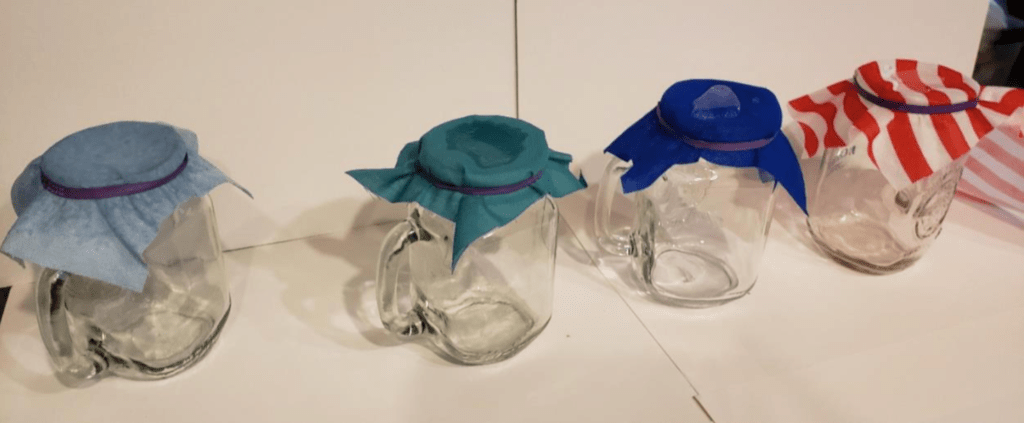
Water Resistance
Information is available on the water resistance of spunbond NWPP materials such as those used in MakerMask designs. Spunbond NWPP is naturally hydrophobic (water-repellent).

4. Desinfección
[Update April 11, 2020] Click here for our post with research and details on mask cleaning and disinfection methods
The fourth key factor for MakerMask designs is whether or not the full mask can be disinfected before use. The current recommendation for home use is to boil masks for 10 minutes prior to use. This procedure was established because “boiling is sufficient to kill pathogenic bacteria, viruses and protozoa (WHO, 2015)”. La duración maximiza desinfección de todas las capas de la máscara. Hervir como un método estandarizado de desinfección casera provee una consistente temperatura máxima bastante debajo del punto de fusion/deformación del PPNT spunbond 100% usado típicamente para bolsas reusables de comprar comida.
A pesar de que procedimientos adicionales para desinfección han sido propuestos, no todos han sido evaluados para éste propósito. En general, químicos agresivos (p.ej. blanqeudora) no están recomendados as residual chemicals in the mask may cause unintended inhalation risks. In addition, oxidizing chemicals may cause the mask materials to degrade more quickly. The longevity of use of community spunbond NWPP masks is currently under investigation.
While awaiting more quantitative evaluation, two qualitative indicators indicate reduction of the functional characteristics of the mask:
- Water-resistance, when water stops beading on the surface during the ‘flick’ test, the droplet protection is degrading and the mask should be retired,
- Shedding, when the bonding of the fibers to the mask starts to degrade and the material starts shedding, the mask should be retired from use as dislodged threads could act as lung irritants (NOTE: landscape cloth and other geotextiles typically fail this assessment prior to first use).
Washing and Disinfection FAQ
PRECAUCIÓN:
Los materiales PPNT usados para artesanía, coser, y otros propósitos pueden derrietirse aunque están listados como 100% polipropileno porque éstas materiales están frecuentemente compuestos de formas menos critalinos de PP con puntos de fusión más cerca a 130o C (266o F). Aunque estos materiales pueden ser lavables, pueden deformar y/o derretirse al ser hervidos, planchados, cuando se cuece al vapor o esterilizado en autoclave.
Final Thoughts on Spunbond NWPP
Algunos benefits of spunbond NWPP include that it is: commonly available in non-woven grocery bags and conference bags, hypoallergenic, water-resistant, conducive to mechanical filtration, and can be disinfected by boiling. Potential drawbacks of community-sourced spunbond NWPP include difficulties identifying suitable materials and variability in NWPP density and structure. These drawbacks can be mitigated by sourcing from more homogeneous subsets of spunbond NWPP based on use case. For example, reusable grocery bags are designed for the same use (carrying loads of food), have more consistent standards for strength, durability, quality, disinfection, and higher melting points than NWPP from other sources.
[Edit: June 26, 2020] For additional information about testing mask materials check out: 3 Easy DIY Mask Tests

For information about “window masks” or “clear face covering” check out: “5 Key Considerations for Window Masks.”



